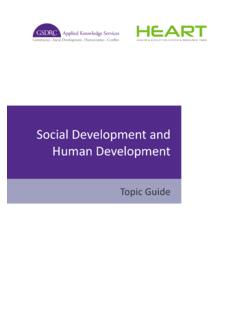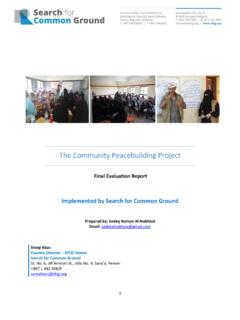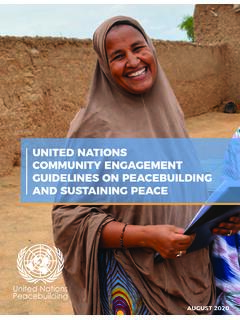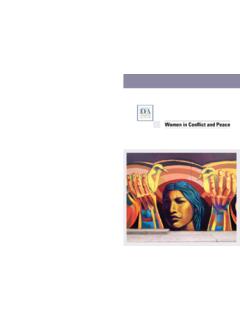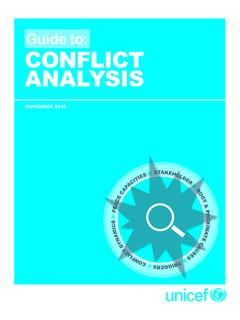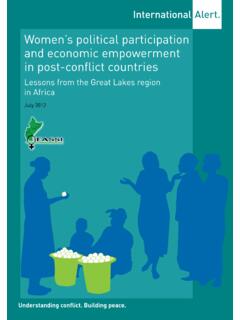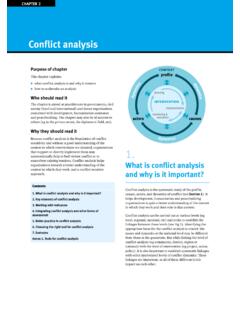Transcription of Gender and Conflict - GSDRC
1 Gender and Conflict Topic Guide About this Topic Guide GSDRC topic guides aim to provide a clear, concise and objective report on findings from rigorous research on critical areas of development policy. Rather than provide policy guidance or recommendations, their purpose is to signpost policymakers and practitioners to the key debates and evidence on the topic of focus to support informed decision-making. This publication complements other GSDRC topic guides on Gender guides/ Gender and Conflict Author and contributors This GSDRC topic guide was written by Anna Louise Strachan ( GSDRC , Institute of Development Studies).
2 And Huma Haider ( GSDRC , University of Birmingham). Its production was supported by the UK. Government. GSDRC appreciates the contributions of Judy El Bushra, Sanam Anderlini, Jessie Kirk, Kathryn Lockett, Adam Forbes, Cyn Gaigals and Mark Segal. We would also like to thank Evie Browne, Claire Mcloughlin, and Brigitte Rohwerder for their input. About GSDRC . GSDRC is a partnership of research institutes, think-tanks and consultancy organisations with expertise in governance, social development, humanitarian and Conflict issues. We provide applied knowledge services on demand and online.
3 Our specialist research team supports a range of international development agencies, synthesising the latest evidence and expert thinking to inform policy and practice. GSDRC . International Development Department, College of Social Sciences University of Birmingham, B15 2TT, UK. DFID Crown Copyright 2015. Licensed under the Open Government Licence: The views expressed in this report are those of the author, and do not necessarily reflect the opinions of GSDRC , its partner agencies or DFID. Suggested citation Strachan, A. L. and Haider, H. (2015). Gender and Conflict : Topic guide.
4 Birmingham, UK: GSDRC , University of Birmingham. Supported by: Contents Executive summary 1. Key definitions 2. 1 Concepts, debates and frameworks 3. Why Gender matters in FCAS 3. International policy frameworks 3. Gender , violence and peace in the post-2015 agenda 6. Current debates and trends in Gender and Conflict 6. 2 Relationship between Gender and Conflict : the evidence 8. Impact of Gender on Conflict 8. Impact of Conflict on Gender 9. 3 Approaches, tools and interventions: building Gender sensitivity in FCAS 13. Conflict prevention 13. Gender -sensitive Conflict analysis 14.
5 Gender -sensitive peacebuilding and statebuilding 15. Addressing Gender inequality 17. Negotiating risks 19. Assessing impact 19. References 20. Executive summary This topic guide responds to the need for deeper understanding of how Gender and Conflict interrelate in fragile and Conflict -affected situations (FCAS), and of Gender -sensitive approaches in such contexts. Drawing on a literature review, it highlights key texts and identifies the strength of evidence alongside gaps in evidence. It summarises the evidence on the role of Gender inequality in producing or exacerbating the structural causes of different forms of violence and Conflict , and on the multi-layered effects of violence and Conflict on Gender relations.
6 The topic guide also signposts evidence on the effects of interventions to support Gender equality in FCAS, and emerging lessons. The evidence base for exploring these issues is limited in a number of ways. Much of the available literature is secondary, and conceptual or normative. Only a few empirical studies, focused on a limited number of countries (mostly in Africa), apply a multi-country comparative approach or qualitative country case study methods. There are few rigorous randomised control trials or impact evaluations able to attribute improved development outcomes or processes of Conflict transformation to Gender -sensitive approaches in FCAS.
7 There are three main arguments in the literature for incorporating Gender in Conflict -related work. One is that promoting women 's and girls' rights in Conflict -affected contexts has instrumental value. Another, rights-based, argument is that Gender equality has intrinsic value. A third is that Gender and Conflict are linked in ways that are poorly understood, and that this deficiency needs to be reversed if real impact is to be realised. Evidence indicates that Conflict affects women , men, girls and boys differently in their experiences of violence, health impacts, economic activity, and political and civic inclusion.
8 Conflict can result in short- term changes in traditional Gender roles , though long-term changes may be more elusive. Both men and women can be the victims and the perpetrators of violence. Barriers to building Gender equality in FCAS include the resilience of patriarchy, violence and women 's exclusion. There are also risks or potential unintended consequences associated with incorporating Gender in Conflict -related work, both for populations and donors. These include potential backlash against women and girls, and the risks of data collection on Gender issues in Conflict -affected contexts.
9 1 Gender and Conflict : Topic Guide, 2015. Key definitions Conflict , violence, and organised violence are the use or threat of physical force by groups (civilians, states, social groups). Conflict and violence take many forms, including outright civil war, large- or small- scale communal conflicts based on regional, ethnic, religious or other groupings, and domestic violence (World Bank, 2011, p. xv). Conflict sensitivity implies understanding Conflict dynamics and the potential effects of interventions on them, to avoid negative impacts and maximise positive ones ( Conflict Sensitivity Consortium, 2012, p.)
10 2). Gender means the socially constructed roles and relationships, personality traits, attitudes, behaviours, values, relative power and influence that society ascribes to the two sexes on a differential basis. Gender is relational and refers not simply to women or men but to the relationship between them' (UN women , 2014, p. 42). Gender relations are relations between men and women , between men, and between women , characterised by negotiation, bargaining and exchange (True, 2013, p. 2). Gender relations, including constructions of masculinities and femininities, determine access to power and resources in society (True, 2013, p.

